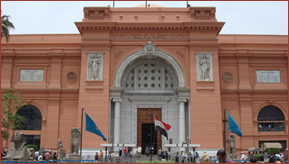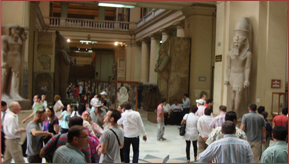Thursday, 5 November 2020
Tuesday, 26 April 2011
Nefertari's temple
Nefertari also known as Nefertari Merytmut was one of the Great Royal Wives (or principal wives) of Ramesses the Great.
Nefertari means 'Beautiful Companion' and Meritmut means 'Beloved of [the Goddess] Mut'. She is one of the best known Egyptian queens, next to Cleopatra, Nefertiti and Hatshepsut. Her lavishly decorated tomb, QV66, is the largest and most spectacular in the Valley of the Queens. Ramesses also constructed a temple for her at Abu Simbel next to his colossal monument here.
Nefertari held many different titles, including: Great of Praises (wrt-hzwt), Sweet of Love (bnrt-mrwt), Lady of Grace (nbt-im3t), Great King’s Wife (hmt-niswt-wrt), Great King’s Wife, his beloved (hmt-niswt-wrt meryt.f), Lady of The Two Lands (nbt-t3wy), Lady of all Lands (hnwt-t3w-nbw), Wife of the Strong Bull (hmt-k3-nxt), God’s Wife (hmt-ntr), Mistress of Upper and Lower Egypt (hnwt-Shm’w-mhw).
Family
Although Nefertari’s origins are unknown, the discovery from her tomb of a knob inscribed with the cartouche of Pharaoh Ay has led people to speculate she was related to him. The time between the reign of Ay and Ramesses II means that Nefertari could not be a daughter of Ay and if any relation exists at all, she would be a grand-daughter. It is possible that Nefertari is the daughter of Mutnodjemet, sister of Nefertiti, and possibly daughter of Ay.[citation needed] There is no conclusive evidence linking Nefertari to the royal family of the 18th dynasty however.
Nefertari married Ramesses II before he ascended the throne. Nefertari had at least four sons and two daughters. Amun-her-khepeshef, the eldest was Crown Prince and Commander of the Troops, and Pareherwenemef would later serve in Ramesses II’s army. Prince Meryatum was elevated to the position of High Priest of Re in Heliopolis. Inscriptions mention he was a son of Nefertari. Prince Meryre is a fourth son mentioned on the façade of the small temple at Abu Simbel and is thought to be another son of Nefertari. Meritamen and Henuttawy are two royal daughters depicted on the façade of the small temple at Abu Simbel and are thought to be daughters of Nefertari.
Princesses named Bak(et)mut, Nefertari, and Nebettawy are sometimes suggested as further daughters of Nefertari based on their presence in Abu Simbel, but there is no concrete evidence for this supposed family relation.
Nefertari first appears as the wife of Ramesses II in official scenes during the first year of Ramesses II. In the tomb of Nebwenenef, Nefertari is depicted behind her husband as he elevates Nebwenenef to the position of High Priests of Amun during a visit to Abydos. Nefertari also appears in a scene next to a year 1 stela. She is depicted shaking two sistra before Taweret, Thoth and Nut.
Nefertari is an important presence in the scenes from Luxor and Karnak. In a scene from Luxor, Nefertari appears leading the royal children. Another scene shows Nefertari at the Festival of the Mast of Amun-Min-Kamephis. The king and the queen are said to worship in the new temple and are shown overseeing the Erection of the Mast before Amen-Re attended by standard bearers.
Nefertari appears as Ramesses II’s consort on many statues in both Luxor and Karnak. In Western Thebes, Nefertari is mentioned on a statuary group from Deir el-BAhari, a stela and blocks from Deir el-Medina.
The greatest honor was bestowed on Nefertari however in Abu Simbel. Nefertari is depicted in statue form at the great temple, but the small temple is dedicated to Nefertari and the goddess Hathor. The building project was started earlier in the reign of Ramesses II, and seems to have been inaugurated by ca year 25 of his reign (but not completed until ten years later).
Nefertari’s prominence at court is further supported by cuneiform tablets from the Hittite city of Hattusas (today Boghazkoy, Turkey), containing Nefertari's correspondence with the king Hattusilis and his wife Pudukhepa. She is mentioned in the letters as Naptera.
Nefertari is shown at the inaugural festivities at Abu Simbel in year 24. Her daughter Meritamen is depicted taking part in place of her mother in some of the scenes. Nefertari may well have been in failing health at this point. After her death she was buried in tomb QV66 in the Valley of the Queens.
Monday, 25 April 2011
Memphis
Memphis was the ancient capital of Aneb-Hetch, the first name of Lower Egypt. Its ruins are located near the town of Helwan, south of Cairo.
According to legend related by Manetho, the city was founded by the pharaoh Menes around 3000 BC. Capital of Egypt during the Old Kingdom, it remained an important city throughout ancient Mediterranean history.
It occupied a strategic position at the mouth of the Nile delta, and was home to feverish activity. Its principal port, Peru-nefer, harboured a high density of workshops, factories, and warehouses that distributed food and merchandise throughout the ancient kingdom. During its golden age, Memphis thrived as a regional centre for commerce, trade, and religion.
 |
| Memphis' map |
Memphis was believed to be under the protection of the god Ptah, the patron of craftsmen. Its great temple, Hut-ka-Ptah (meaning "Enclosure of the ka of Ptah"), was one of the most prominent structures in the city.
The name of this temple, rendered in Greek as Aί γυ πτoς (Ai-gy-ptos) by the historian Manetho, is believed to be the etymological origin of the modern English name Egypt.
The history of Memphis is closely linked to that of the country itself. Its eventual downfall is believed to be due to the loss of its economical significance in late antiquity, following the rise of coastal Alexandria. Its religious significance also diminished after the abandonment of the ancient religion following the Edict of Thessalonica.
The ruins of the former capital today offer fragmented evidence of its magnificent past. They have been preserved, along with the pyramid complex at Giza, as a World Heritage Site since 1979. The site is open to the public as an open-air museum.
Location
The ruins of Memphis are 20 km (12 miles) south of Cairo, on the west bank of the Nile. The modern cities and towns of Mit Rahina, Dahshur, Abusir, Abu Gorab, and Zawyet el'Aryan, south of Cairo, all lie within the administrative borders of historical Memphis.
The city was also the place that marked the boundary between Upper and Lower Egypt. (The 22nd city of Upper Egypt and 1st city of Lower Egypt).
History
Memphis became the capital of Ancient Egypt for over eight consecutive dynasties during the Old Kingdom. The city reached a peak of prestige under the 6th dynasty as a centre for the worship of Ptah, the god of creation and artworks. The alabaster sphinx that guards the Temple of Ptah serves as a memorial of the city's former power and prestige.
The Memphis triad, consisting of the creator god Ptah, his consort Sekhmet, and their son Nefertem, formed the main focus of worship in the city.
Memphis declined briefly after the 18th dynasty with the rise of Thebes and the New Kingdom, and was revived under the Persians before falling firmly into second place following the foundation of Alexandria. Under the Roman Empire, Alexandria remained the most important city. Memphis remained the second city of Egypt until the establishment of Fustat (or Fostat) in 641 CE. It was then largely abandoned and became a source of stone for the surrounding settlements. It was still an imposing set of ruins in the 12th century but soon became a little more than an expanse of low ruins and scattered stone.
Subscribe to:
Posts (Atom)






